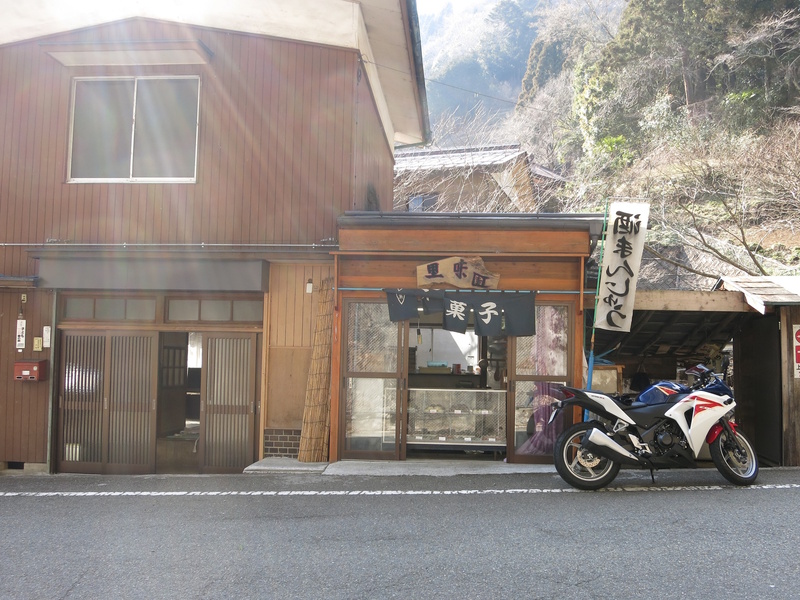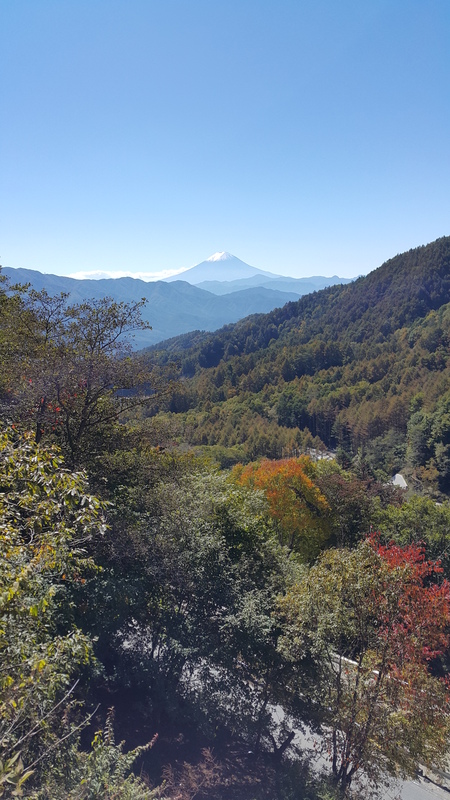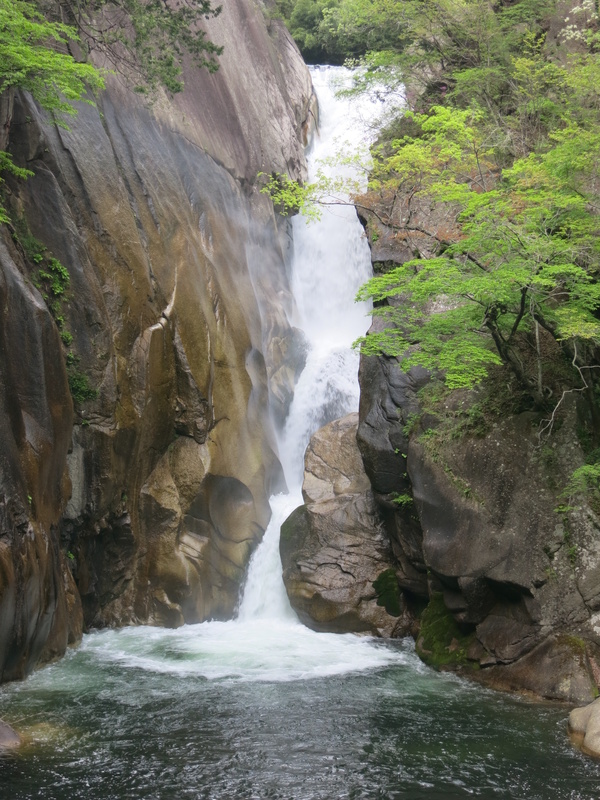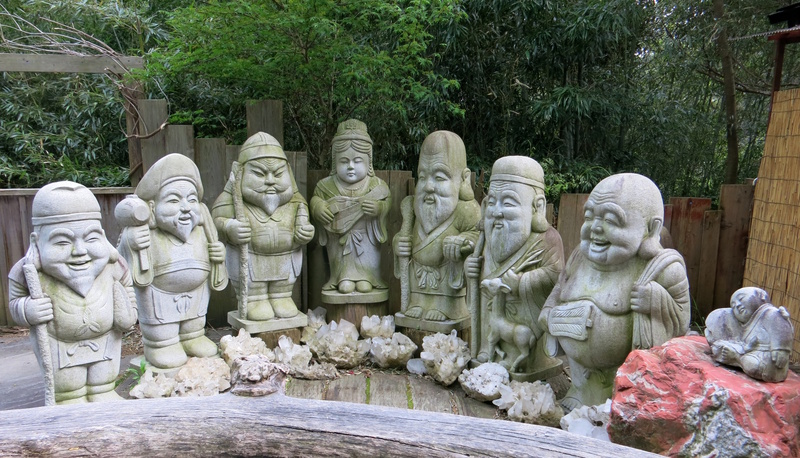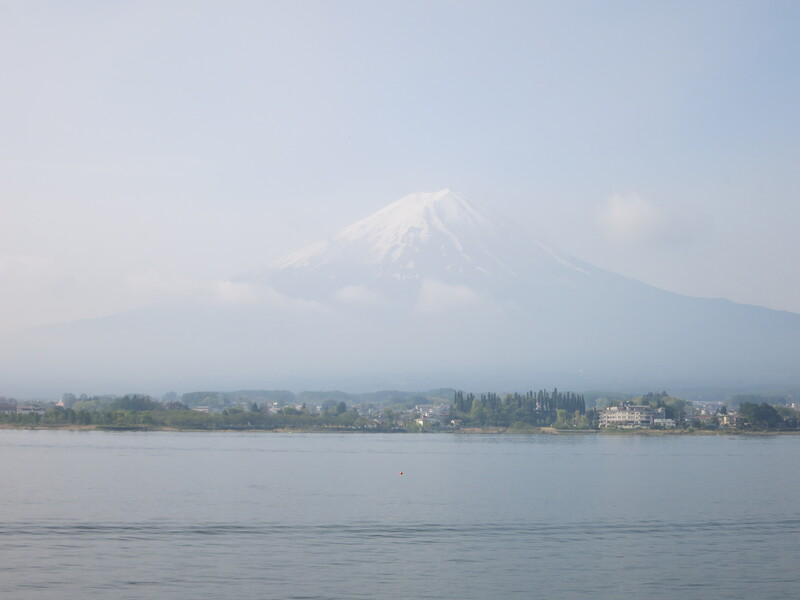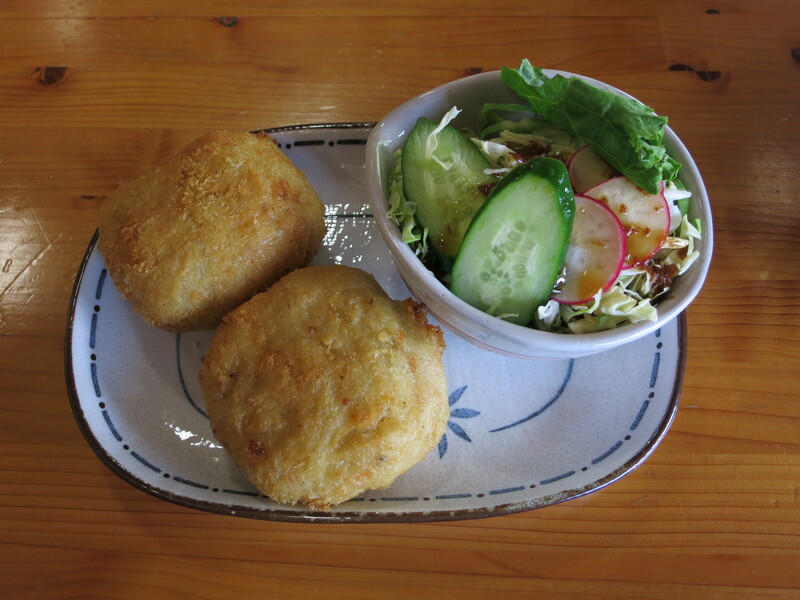Riding in Western Tokyo
2014-03-25
I like to get on my motorcycle and ride west. The mountains are there, the roads are light on traffic, and the scenery is excellent.
Riding in Akiruno
Spring break and sunny weather are great for motorcycle rides. On March 25, 2014, I had plans to ride down a ramen shop in Hachioji (in western Tokyo), so I got on my bike and headed west. But as I headed west, the road somehow grew on me. Surely it was not the slow, slow pace. The road, Itsukaichikaido, is two lane with many traffic lights and a handful of railroad crossings. It's narrow, and there are no shoulders for surreptitious passing. Yet somehow, I wanted to know where it went. To be clear, I knew it headed west and that there are mountains to the west. But I didn't know what these mountains on this road looked like. So the ramen shop moved to back burner, at most a footnote for some future day, and I went to Akiruno.
I would start in Golden Gate Park, thinking only to run a few long curves to clear my head…but in a matter of minutes I’d be out at the beach with the sound of the engine in my ears, the surf booming up on the sea wall and a fine empty road stretching all the way down to Santa Cruz…not even a gas station in the whole seventy miles; the only public light along the way is an all-night diner down around Rockaway Beach.
— Hunter S. Thompson. Hell's Angels, 1963.
Highway 33 runs from Musashi-Itsukaichi Station in Akiruno to the Chuo Expressway interchange in Uenohara. The lines and squiggles on the map should suggest that there are curves and hills along the road, and there are. This particular road is great for riding but not for sightseeing because it has few views. If you're taking the road, you're not searching for panoramic view-of-Mt. Fuji pullouts, for none can be found here. This probably sucks if you're an aspiring photographer. For a fan of the open road looking to enjoy the forest valleys and slow flowing streams, though, it's great. Motorcycle riding in the mountains is calm and refreshing.
Walk along the river, sweet lullaby, it just keeps on flowing,
It don't worry 'bout where it's going, no, no.
Don't fly, mister blue bird, I'm just walking down the road,
Early morning sunshine tell me all I need to know.
— The Allman Brothers. Blue Sky, 1971.
Riding in Okutama
On March 28, 2014, I went on a 150 km ride up to Okutama, down to Uenohara, and back. When you're going west from my place, you could take Itsukaichikaido, which is what I tried the other day. Itsukaichikaidō is a slow two lane road. The next road north of it, Ōme Kaidō (in places, Shin-Ōme Kaidō), is four lanes and reasonably fast. It took an hour and a half to get to the edge of the city. On the outskirts of Tokyo, the four lanes drop to two, and the traffic drops to almost none. Then there are hills, and Route 411 takes you up into the mountains. After twenty minutes, you get to Lake Okutama. The road follows the lake edge for several kilometers, and if you miss a turn either you'll slam into the rock wall or fly off the edge and go for a swim. If I had to choose, the swim sounds better.
At this point, you could have lunch, turn around, and go home. It would be a successful day. I didn't have any food and instead went south on Route 139 and Route 18. After an hour of slow twisting and weaving on mostly abandoned mountain roads, I came to a small hamlet at around 35.68522, 139.048934. There were several houses but no grocery stores or gas stations. There was no fire station that I saw. By the side of the road there was a one-person police station, and next to that was a house with a sign in front of it that said, "manju". "Manju", as you may know, is a kind of steamed bread. I'd never heard of a hamlet with a manju shop but no grocery store, but the situation had an overall air of excellence to it. Why not have a little manju shop — by the name of "Satsumien" (里味園) — in the middle of nowhere on a road that nobody drives? What better place could you find? "This is Japan," I thought, and it was. The manju tasted great.
The CBR250R's fuel economy is good. I get around 75 miles / gallon. This is equivalent to 3.14 liters / 100 km. A close-to-full tank of gas costs around ¥1200 ($12). The tank itself is 3.4 gallons, so the range on a single tank is 255 miles, or around 400 km. One big difference between a motorcycle and car is the number of stops. When you're driving a car, you have to stop to fill up on gas and to use the restroom once every four to five hours, depending how much coffee you drink. On a motorcycle, it's nice on the body to take five minute breaks to stretch and have some water every one or two hours. After all, you can't move around much while riding a bike, and beverages are right out the window.
Okutama (奥多摩町) is a town located in Nishitama District, Tokyo Metropolis, Japan. As of August 1, 2007, the town had a population of 6712 people... With an area of 225.63 km², it is the largest community in Tokyo. Mount Kumotori, Tokyo's highest peak at 2017 m, divides Okutama from the Okuchichibu region of the neighboring Saitama and Yamanashi Prefectures. Tokyo's northernmost and westernmost points lie in Okutama, as does Lake Okutama, an important source of water for Tokyo, situated above the Ogōchi Dam in the town.
— Wikipedia, 2014-03-28.
Riding in Hanno
April 13, 2014, was a cloudy day. In the afternoon it was cold in my normal jeans and riding jacket, and I put on my rain suit over top them to block out the cutting wind. When I left for Hannō, the sun was a fuzzy ball of yellow hiding behind a moderate cloud layer, and by the time I got home it had been replaced by the moon.
Though the scenery was serene, some of the houses were ugly. In places with space, there's no need to get rid of old things. You put them in the corner, just in case. Several decades later, those things are still there — tractor parts, rusty pieces of sheet metal, broken cars and kerosene heaters — all things that someone though they might use again but never did. At first glance, that's what I saw. That's what I saw because that's what was there, but that's not all there was to see. By the stream running through town, several children were playing. An old man was sitting on a folding chair with a fishing rod and a six pack. A woman was hanging laundry on a second floor balcony clothes line. A grandmother was standing by the side of the road leaning on her cane looking both directions waiting for the moment when traffic would somehow be thin enough for her to make it across the highway without getting hit. As a practical matter, this should have been no matter — the number of cars per hour could be counted on your fingers. On the hill sides, above and around the small rice fields and gardens with green onions and cabbage, were cherry trees in bloom. Tokyo's cherry blossom season flitted by two weeks ago, but up here in the mountains things move more slowly.
Hanno is about ninety minutes from my apartment. On the way out, I took Ome Kaido. On the way back I took Route 463 Bypass. Both are four-lane roads, and though traffic crawled occasionally, overall the speed was reasonable.
Riding in Gunma
On May 20, 2014, I rode my motorcycle up to Mt. Akagi (赤城山) in Gunma. My plan was to ride Mt. Akagi and Mt. Haruna, the latter of which is prominently featured in the anime Initial D. But in the afternoon it was cloudy, and I ran low on time, so after a lap around Mt. Akagi I headed home.
It takes a long time to get that far, and I took the express way both directions. At an expensive ¥2,800 each direction, this is not something I'd recommend to others. Up in Gunma, the mountain roads are very nice. Curves are plentiful, the road quality is generally good, and traffic is sparse. But spending an hour on the expressway, combined with the extravagant toll fare, is unsatisfying. If you live in the region, give Mt. Akagi a spin. But if you're starting in Tokyo, you might be better off with day trips to Chiba, Hanno, or Okutama.
Today was a test ride with my new saddlebags. The Degner NB-37 saddlebags are a fairly stiff cloth with plastic sheets on the sides to hold form. The bags are expandable. Each bag holds 18L and expands up to 25L, giving an overall capacity of 36L or 50L. These bags were the only ones at the store that are both designed for a sport bike and large enough to fit my tent, sleeping bag, and camping gear. The saddlebags rest on the seat and are attached to the bike by three straps: one connecting to each passenger foot-rest and one going under the brake light. There is not much room for flexibility with these bags, which might make riding with a passenger difficult. I could lower them an inch or two, and I could move them back an inch or two. The bags angle inward slightly, but there is no risk of hitting the rear tire because they are quite high up on the bike. These bags are not lockable, and anyway they're soft sided, so I take my valuables with me when I park. For today's ride, I had a very light load of 1.5L of water and a bunch of clothes in each of the bags. Everything was smooth. Good!
On my last trip I tested out my handlebar mount with smart phone. Today I used it again. As expected, a smart phone with the screen on goes through batteries very quickly. I was on the road for around six hours today. My phone battery is good for around three hours on its own. By throwing in my battery pack, I get something like triple the time. For longer trips, though, there are often long stretches on the same road, in which case there's no reason to have the display activated. GPS tracking without the display uses some power, but not nearly as much as the display does. My riding gloves work with a touch screen, and the case is touch screen compatible. I can zoom and drag the screen without taking off my gloves or taking the phone out of the case. For navigation, the setup worked out very well.
Riding in Otsuki
On May 30, 2014, I went for a motorcycle ride to Otsuki, a town in eastern Yamanashi Prefecture. The plan was to climb Gangaharasuriyama (雁ガ腹摺山), as detailed on Wikivoyage, and get a great view and photograph of Mount Fuji. Also, the plan was to ride the motorcycle in great weather.
The weather was friendly, but Mount Fuji was shy. As often happens, Mount Fuji hid behind the clouds. The nearby mountain ranges weren't so shy. I got some nice views from overlooks and the summit. The hike itself begins at Otoge (大峠), the nearby mountain pass and parking lot. There's a picnic cabin at Otoge and a water source one hundred meters up the trail towards Gangaharasuriyama. You could comfortably stealth camp there. The road leading to the pass starts in the south near central Otsuki and would continue north past the small parking lot through the pass, but there's a sign and locked gate. I didn't read the sign, but probably the city to the north of Otsuki decided not to repair the road after a rock fall or similar incident, and in the interest of safety they just gated the road off.
After the hike, I rode back to central Otsuki and took Route 139 north. My plan was to go through the mountain town of Okutama and then hop on Ome Kaido and ride that through Tokyo back to my house. What I didn't realize, though, is that to get to Okutama you have to take Route 139 over a mountain called Matsuhimetoge (松姫峠). Exactly what kind of crazy freak would design a road that goes up and over a mountain with fifty thousand sharp turns, all of which are on exposed corners where an accident would certainly result in serious injury I do not know. What I know is that that person designed a road that makes for spectacular riding. It was pretty awesome. Wikipedia says that in 2012 they started building a tunnel under the mountain. After they finish the tunnel, they might close the road above. Get your ride in while you can.
Riding in Katsunuma
The autumn is great weather for a motorcycle trip, and on October 13, 2015, I went to Katsunuma and back. Katsunuma is a small town in eastern Yamanashi that's known for little except that the region grows a lot of grapes. There are dozens of grape shops, and the fall is a good time for sampling them.
I took the Chuo Expressway on the way there. It was fast and notable because at the rest area near Otsuki we had a nice view of Mount Fuji. In Katsunuma, I ate some grapes, bought some grapes, and headed towards the mountains. You can if you like go by twisty mountain roads from Katsunuma to Akiruno in western Tokyo. This is cheaper than the expressway, but it takes longer. The good thing is that the roads are so curvy and slow that most people won't drive them. Plus there are some nice views. Some of the trees were starting to change color, but it's still a little early for leaf season in this region.
Riding in Yamanashi
Over Golden Week, I took two days (May 2 and 3, 2016) and went on a motorcycle ride to Yamanashi.
The first day I took Ome Kaido (青梅街道) west, then hopped on the highway to Chichibu. There was a traffic jam in central Chichibu around lunchtime. If you're going through the town during tourist season, try to get an early start. After the traffic jam, the roads were clear cruising. With light cloud cover, I headed southwest towards Yamanashi and Kofu. Northern Kofu is home to Shosenkyo Gorge (昇仙峡). The gorge has an excellent waterfall, and although the guidebook recommended an autumn visit I was satisfied with spring. That evening, I stayed at a Route Inn in Minami-Alps.
The next morning I got on the road by 6:30. Early mornings are light on traffic and the sun is low in the sky and creates pretty lighting. Some small mountain roads took me to Lake Kawaguchi, complete with a hazy view of Mount Fuji, and some others took me back to Tokyo.
Riding in Uenohara
I took a day trip to Uenohara on May 31, 2016. I've ridden this road twice before, so today I took the loop in the other direction. The road is different going the other way, and it was a fun twist. For lunch I stopped at a rest area and restaurant called Biryukan. The menu was very interesting. They had soba and dry curry, which you can find anywhere, but they also had a special kind of croquette. More surprisingly, they served obaku, a kind of porridge with the consistency of oatmeal. You mix sliced green onions into miso paste, and add that mixture to the porridge as desired. This kind of food is hard to find. I'd never had it. I'd never seen it before.
Also, the weather was perfect for riding. Light clouds, not too hot, light wind, low traffic, good times.

